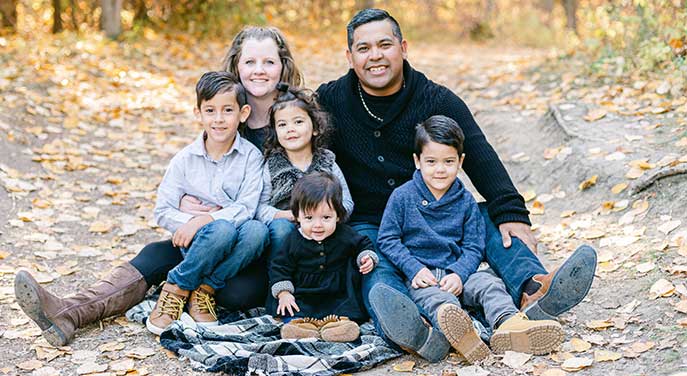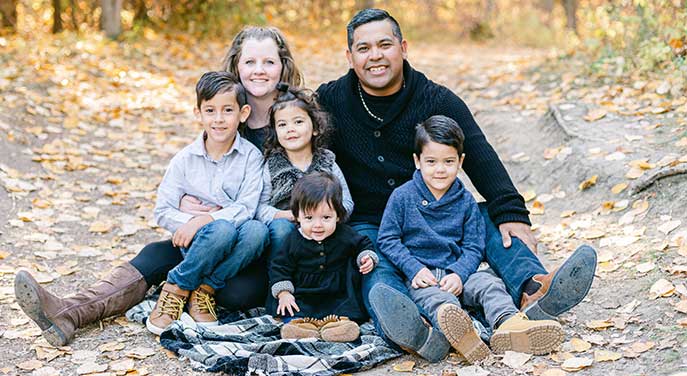
Alexandra and Walter Perez say their son Armando (right) started kindergarten this year with a new lease on life after taking part in a clinical trial of a new drug that has eased his symptoms of PFIC, a rare genetic disorder that causes constant itchiness. (Photo: Shania Leigh Imagery)
It was a Friday afternoon, and Alexandra was running errands when she looked down at her five-month-old son Armando and thought, “You know, he looks really yellow, like jaundice, like a newborn would look.” She took him to their family doctor that same day and, by Monday, was told to go straight to the Stollery Children’s Hospital.
It would be a month before Alexandra and Walter Perez would get confirmation that their son has progressive familial intrahepatic cholestasis (PFIC) – a rare genetic disorder that causes progressive liver disease and typically leads to liver failure.

Susan Gilmour
“This is a disease with a spectrum of severity from symptoms once in a while, to moderate issues, to a very severe impact that requires a liver transplant in infancy,” explains Armando’s doctor, Susan Gilmour, a pediatric gastroenterologist and member of the Women and Children’s Health Research Institute (WCHRI) who specializes in liver disease at the Stollery.
There is no cure, so current treatments for PFIC focus on delaying a liver transplant and improving quality of life by addressing symptoms. The main symptom of PFIC is pruritus, or severe itchiness. Armando’s itchiness and scratching were all-consuming and compulsive; they became the focus of his life.
“He had scars all over his arms, his legs, his face, just everywhere,” says Alexandra. “It was so bad that he couldn’t sleep. He would be awake all night scratching, and then you would find him in the morning sleeping on the stairs or on the floor in the kitchen in the middle of the day because he just couldn’t rest at night.”
Doctors tried various medications to address the symptom, with no real improvement. “We couldn’t just use something like a lotion or another medication,” Walter explains. “We felt our hands were tied when it came to trying to help him with that because he was itchy from the inside.”
By the time Armando was nearing his fifth birthday, he had been living with the itchiness of PFIC for most of his life. He was losing weight and was in such discomfort that he didn’t have the energy to interact or play with his siblings.
In 2019, Alexandra and Walter learned about clinical trial research studies at a PFIC Advocacy & Resource Network family conference in Cincinnati, Ohio. Alexandra saw a glimmer of hope and pursued this with Gilmour to try to find a way for Armando to join a study that could potentially help him.
Clinical trials for rare diseases usually co-ordinate with multiple sites in different regions or even countries. The Stollery Children’s Hospital is one of only three liver transplant centres in Canada for children and has the largest referral practice in pediatric liver disease. The Stollery had several patients, including Armando, who potentially fit the criteria to participate in an available clinical trial. The Stollery also had a dedicated pediatric clinical investigation unit and an international reputation for well-run research studies through a partnership with WCHRI at the University of Alberta.
“The Stollery has a reputation of being an excellent partner in pediatric clinical trials, and so much of that is thanks to WCHRI and the people who work there in research administration and directly with the patients,” says Gilmour.
For the Perez family, participation in the clinical trial offered hope for their son.
“It was a game changer for us – because he would have been heading down the road of an early liver transplant to try to address the itching if he wouldn’t have been included in the trial,” says Walter.
Armando started in the trial in January 2021, after a delay due to COVID-19 safety measures. The first six months were hard as Armando’s condition worsened, and the family couldn’t be told whether he was taking the active medication or a placebo, says Walter. “We were putting all of our hopes in this trial.”
By July, the first study was over, and Armando was enrolled in an extension study, where all participants were openly offered the active medication.
“Within two days, he had zero itch. Two. Days. Honestly, it was amazing,” says Alexandra.
The change in Armando, now no longer focused on scratching to survive, was profound. He was sleeping, eating and gaining weight. “And when the itch stopped, we suddenly got our boy back,” says Walter. “It’s like we actually got to meet Armando. It was weird. We thought, ‘Oh, this is your personality! This is what you enjoy doing. This is what you like.’ Before that, it was hard to tell.”
Gilmour agrees that the difference the clinical trial has made in Armando’s quality of life is clear, and she hopes the impact will ripple out to other patients and their families. “I am hopeful that this new treatment will help us postpone transplantation until children are older, or maybe even avoid a liver transplant just because of a failure to gain weight when they are young.”
| By Judith Chrystal
Judith Chrystal is a reporter with the University of Alberta’s Folio online magazine. The University of Alberta is a Troy Media Editorial Content Provider Partner.
The opinions expressed by our columnists and contributors are theirs alone and do not inherently or expressly reflect the views of our publication.
© Troy Media
Troy Media is an editorial content provider to media outlets and its own hosted community news outlets across Canada.

